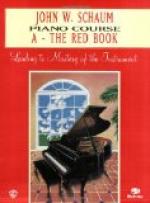“The G minor Ballade, of Chopin, begins slowly, with much dignity. The opening melody is one of sadness, almost gloom. The a tempo on second page contains four parts going on at the same time. At the piu forte, care must be taken to have the outer side of the hand well raised, and moved from the wrist. The idea here is one of great agitation and unrest. The fifth page needs great power and the legato octaves well connected and sustained. The feeling of unrest is here augmented until it becomes almost painful, and not until the animato does a restful feeling come. This should be played lightly and delicately, the left hand giving the rhythm. The presto demands great power and dash. Let the wrist be low when beginning the chords, raise it after the first and let it fall after the second. Always accent the second chord. Begin the final double runs slowly and increase in speed and tone. So, too, with the octaves, begin slowly and increase in power and fire.”
Numerous other compositions were analyzed, but the ones already quoted stand out in memory, and give some idea of Mr. Sherwood’s manner of teaching.
DR. WILLIAM MASON
Years after the foregoing experiences I had the privilege of doing some work with the dean of all American piano masters, Dr. William Mason. I had spent several years in European study, with Scharwenka, Klindworth and von Buelow, and had returned to my own land to join its teaching and playing force. My time soon became so largely occupied with teaching that I feared my playing would be entirely pushed to the wall unless I were under the guidance of some master. With this thought in mind, I presented myself to Dr. Mason.
“You have studied with Sherwood,” he began. “He has excellent ideas of touch and technic. Some of these ideas came from me, though I don’t wish to claim too much in the matter. Sherwood has the true piano touch. Very few pianists have it; Klindworth did not have it, nor von Buelow, nor even Liszt, entirely, for he as well as the others, sought for a more orchestral manner of playing. Sherwood has this touch; Tausig had it, and de Pachmann and Rubinstein most of all. It is not taught in Germany as it should be. The best American teachers are far ahead in this respect; in a few years the Europeans will come to us to learn these things.” (This was Sherwood’s idea also.)
The first composition played to Dr. Mason was the G minor Rhapsodie of Brahms, with which, as it happened, he was unfamiliar. I played the entire piece through without interruption, and he seemed pleased.
“You have a beautiful tone—a really beautiful tone, and you play very artistically; much of this must be natural to you, you could not have acquired it. You also have an excellently trained hand. I may say that in my forty years of teaching I have never had any one come to me with a better position, or more natural and normal condition. Now, what do you think I can do for you?”




